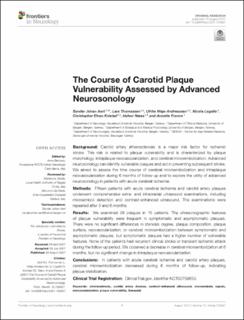| dc.contributor.author | Aarli, Sander Johan | |
| dc.contributor.author | Thomassen, Lars | |
| dc.contributor.author | Waje-Andreassen, Ulrike | |
| dc.contributor.author | Logallo, Nicola | |
| dc.contributor.author | Kvistad, Christopher Elnan | |
| dc.contributor.author | Næss, Halvor | |
| dc.contributor.author | Fromm, Annette | |
| dc.date.accessioned | 2021-11-26T13:09:38Z | |
| dc.date.available | 2021-11-26T13:09:38Z | |
| dc.date.created | 2021-10-15T21:57:03Z | |
| dc.date.issued | 2021-08-20 | |
| dc.identifier.issn | 1664-2295 | |
| dc.identifier.uri | https://hdl.handle.net/11250/2831692 | |
| dc.description.abstract | Background: Carotid artery atherosclerosis is a major risk factor for ischemic stroke. This risk is related to plaque vulnerability and is characterized by plaque morphology, intraplaque neovascularization, and cerebral microembolization. Advanced neurosonology can identify vulnerable plaques and aid in preventing subsequent stroke. We aimed to assess the time course of cerebral microembolization and intraplaque neovascularization during 6 months of follow-up and to explore the utility of advanced neurosonology in patients with acute cerebral ischemia.
Methods: Fifteen patients with acute cerebral ischemia and carotid artery plaques underwent comprehensive extra- and intracranial ultrasound examinations, including microemboli detection and contrast-enhanced ultrasound. The examinations were repeated after 3 and 6 months.
Results: We examined 28 plaques in 15 patients. The ultrasonographic features of plaque vulnerability were frequent in symptomatic and asymptomatic plaques. There were no significant differences in stenosis degree, plaque composition, plaque surface, neovascularization, or cerebral microembolization between symptomatic and asymptomatic plaques, but symptomatic plaques had a higher number of vulnerable features. None of the patients had recurrent clinical stroke or transient ischemic attack during the follow-up period. We observed a decrease in cerebral microembolization at 6 months, but no significant change in intraplaque neovascularization.
Conclusions: In patients with acute cerebral ischemia and carotid artery plaques, cerebral microembolization decreased during 6 months of follow-up, indicating plaque stabilization. | en_US |
| dc.language.iso | eng | en_US |
| dc.publisher | Frontiers | en_US |
| dc.rights | Navngivelse 4.0 Internasjonal | * |
| dc.rights.uri | http://creativecommons.org/licenses/by/4.0/deed.no | * |
| dc.title | The Course of Carotid Plaque Vulnerability Assessed by Advanced Neurosonology | en_US |
| dc.type | Journal article | en_US |
| dc.type | Peer reviewed | en_US |
| dc.description.version | publishedVersion | en_US |
| dc.rights.holder | Copyright 2021 the authors | en_US |
| dc.source.articlenumber | 702657 | en_US |
| cristin.ispublished | true | |
| cristin.fulltext | original | |
| cristin.qualitycode | 1 | |
| dc.identifier.doi | 10.3389/fneur.2021.702657 | |
| dc.identifier.cristin | 1946360 | |
| dc.source.journal | Frontiers in Neurology | en_US |
| dc.identifier.citation | Frontiers in Neurology. 2021, 12, 702657. | en_US |
| dc.source.volume | 12 | en_US |

